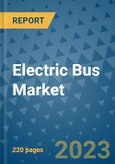Market Insights
The electric bus market has experienced consistent growth through 2024, fueled by regulatory policies, rising environmental awareness, and public demand for cleaner, quieter transportation systems. Asia Pacific led the global Analysis, with China contributing more than half of the total market share. Innovations in battery technology, increased investment in charging infrastructure, and supportive policies played a critical role. However, high upfront costs and limited charging infrastructure continued to act as barriers in underdeveloped regions.Looking ahead, the market will witness accelerated growth due to the maturation of battery technologies, integration with smart transportation networks, and an ongoing global push toward decarbonization. Emerging and developed economies alike are focusing on sustainable urban transport solutions, signaling robust demand for electric buses in the years ahead.
Key Market Drivers
Stringent emission regulations and environmental sustainability mandates are at the core of electric bus market growth. Governments across regions are enforcing low-emission zones, implementing carbon-neutral transport goals, and introducing subsidies, grants, and tax incentives for electric vehicle (EV) purchases.Public demand for improved urban mobility and sustainable living is fueling the transition to electric public transit. From megacities to tier-2 towns, citizens are increasingly advocating for environmentally friendly transport systems that minimize noise and reduce air pollution.
In addition, expansion in global battery production capacity and technological improvements-particularly in energy density and charging speeds-are helping reduce the total cost of ownership for electric buses, making them more attractive to municipal transit authorities.
Business Opportunities
One of the major opportunities in the electric bus market lies in battery innovation. The development and commercialization of solid-state batteries, with higher energy densities and shorter charging times, hold the potential to resolve current performance limitations. As battery reliability and affordability improve, electric buses will be able to serve both high-frequency city routes and longer intercity journeys.Another significant opportunity is the integration of electric buses into smart city infrastructure. Real-time monitoring systems, telematics, and connected vehicle technologies are being deployed in electric buses to optimize route planning, energy consumption, and fleet coordination. As smart city programs scale globally, electric buses are expected to play a central role in connected, sustainable urban ecosystems.
Regional Analysis
Asia Pacific
Asia Pacific continues to lead the global electric bus market, with China accounting for the majority of the region’s market share. The country benefits from a mature EV ecosystem, including large-scale battery production, domestic OEM dominance, and aggressive public transport electrification mandates. India is also gaining traction with initiatives like FAME (Faster Adoption and Manufacturing of Hybrid and Electric Vehicles), spurring state-level tenders and encouraging OEM investment. The region’s high urban density, worsening pollution, and regulatory push are driving substantial adoption across metropolitan and mid-sized cities.Europe
Europe is fast becoming a critical growth region, backed by regulatory consistency across the European Union, strong public funding, and city-level commitments to net-zero transport. Initiatives such as the EU Green Deal and Fit for 55 are accelerating fleet electrification. Major cities including London, Paris, and Berlin are phasing out diesel buses and deploying battery electric buses (BEBs) to meet climate goals. OEMs like VDL, Solaris, and Volvo are offering tailored solutions for European urban mobility needs, supported by infrastructure expansion and intelligent fleet management technologies.North America
North America is experiencing steady growth, largely driven by the United States' federal-level funding programs, including the Low or No Emission Vehicle Program and the Infrastructure Investment and Jobs Act (IIJA). Leading transit agencies are implementing long-term electrification strategies, while OEMs like Proterra and New Flyer scale operations to meet demand. Canada is also investing through its Zero Emission Transit Fund, enabling municipalities to transition public fleets to electric. Growing public awareness, climate goals, and utility company support are shaping a sustainable future for electric mobility in North America.Key Players
The electric bus market is characterized by intense competition and technological innovation. Major global players are leveraging battery advancements, regional partnerships, and scalable production models to strengthen their market position. Prominent companies include:- BYD
- Yutong
- Proterra
- Volvo Buses
- New Flyer
- Tata Motors
- Solaris
- Scania
- Alexander Dennis
- MAN Truck & Bus
- Mercedes-Benz (Daimler)
- NFI Group
- Lion Electric
- VDL Bus & Coach
- Hitachi Zosen
Segmentation
By Propulsion Type
- Battery Electric Vehicle (BEV)
- Plug-in Hybrid Electric Vehicle (PHEV)
- Fuel Cell Electric Vehicle (FCEV)
By Range
- Up to 200 km
- 201-400 km
- Above 400 km
By Application
- Intra-city Buses
- Intercity Buses
By Region
- North America
- Europe
- Asia Pacific
- Latin America
- Middle East & Africa
This product will be delivered within 1-3 business days.
Table of Contents
Companies Mentioned
- BYD
- Yutong
- Proterra
- Volvo Buses
- New Flyer
- Tata Motors
- Solaris
- Scania
- Alexander Dennis
- MAN Truck & Bus
- Mercedes-Benz (Daimler)
- NFI Group
- Lion Electric
- VDL Bus & Coach
- Hitachi Zosen








